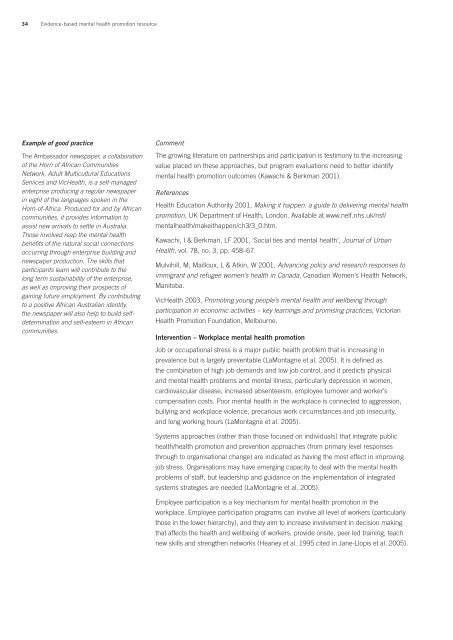Evidence-based mental health promotion resource - health.vic.gov.au
Evidence-based mental health promotion resource - health.vic.gov.au
Evidence-based mental health promotion resource - health.vic.gov.au
Create successful ePaper yourself
Turn your PDF publications into a flip-book with our unique Google optimized e-Paper software.
34 <strong>Evidence</strong>-<strong>based</strong> <strong>mental</strong> <strong>health</strong> <strong>promotion</strong> <strong>resource</strong>Example of good practiceThe Ambassador newspaper, a collaborationof the Horn of African CommunitiesNetwork, Adult Multicultural EducationsSer<strong>vic</strong>es and VicHealth, is a self-managedenterprise producing a regular newspaperin eight of the languages spoken in theHorn-of-Africa. Produced for and by Africancommunities, it provides information toassist new arrivals to settle in Australia.Those involved reap the <strong>mental</strong> <strong>health</strong>benefits of the natural social connectionsoccurring through enterprise building andnewspaper production. The skills thatparticipants learn will contribute to thelong term sustainability of the enterprise,as well as improving their prospects ofgaining future employment. By contributingto a positive African Australian identity,the newspaper will also help to build selfdeterminationand self-esteem in Africancommunities.CommentThe growing literature on partnerships and participation is testimony to the increasingvalue placed on these approaches, but program evaluations need to better identify<strong>mental</strong> <strong>health</strong> <strong>promotion</strong> outcomes (Kawachi & Berkman 2001).ReferencesHealth Education Authority 2001, Making it happen: a guide to delivering <strong>mental</strong> <strong>health</strong><strong>promotion</strong>, UK Department of Health, London. Available at www.nelf.nhs.uk/nsf/<strong>mental</strong><strong>health</strong>/makeithappen/ch3/3_0.htm.Kawachi, I & Berkman, LF 2001, ‘Social ties and <strong>mental</strong> <strong>health</strong>’, Journal of UrbanHealth, vol. 78, no. 3, pp. 458–67.Mulvihill, M, Mailloux, L & Atkin, W 2001, Advancing policy and research responses toimmigrant and refugee women’s <strong>health</strong> in Canada, Canadian Women’s Health Network,Manitoba.VicHealth 2003, Promoting young people’s <strong>mental</strong> <strong>health</strong> and wellbeing throughparticipation in economic activities – key learnings and promising practices, VictorianHealth Promotion Foundation, Melbourne.Intervention – Workplace <strong>mental</strong> <strong>health</strong> <strong>promotion</strong>Job or occupational stress is a major public <strong>health</strong> problem that is increasing inprevalence but is largely preventable (LaMontagne et al. 2005). It is defined asthe combination of high job demands and low job control, and it predicts physicaland <strong>mental</strong> <strong>health</strong> problems and <strong>mental</strong> illness, particularly depression in women,cardiovascular disease, increased absenteeism, employee turnover and worker’scompensation costs. Poor <strong>mental</strong> <strong>health</strong> in the workplace is connected to aggression,bullying and workplace violence, precarious work circumstances and job insecurity,and long working hours (LaMontagne et al. 2005).Systems approaches (rather than those focused on individuals) that integrate public<strong>health</strong>/<strong>health</strong> <strong>promotion</strong> and prevention approaches (from primary level responsesthrough to organisational change) are indicated as having the most effect in improvingjob stress. Organisations may have emerging capacity to deal with the <strong>mental</strong> <strong>health</strong>problems of staff, but leadership and guidance on the implementation of integratedsystems strategies are needed (LaMontagne et al. 2005).Employee participation is a key mechanism for <strong>mental</strong> <strong>health</strong> <strong>promotion</strong> in theworkplace. Employee participation programs can involve all level of workers (particularlythose in the lower hierarchy), and they aim to increase involvement in decision makingthat affects the <strong>health</strong> and wellbeing of workers, provide onsite, peer led training, teachnew skills and strengthen networks (Heaney et al. 1995 cited in Jane-Llopis et al. 2005).



